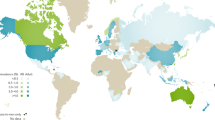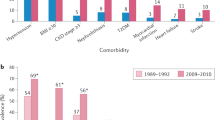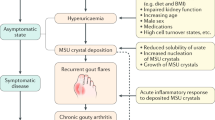Abstract
Gout is one of the most common inflammatory arthritides, which is considered to be a true crystal deposition disorder caused by the formation of monosodium urate crystals in and around joints. A number of epidemiological studies from a diverse range of countries suggest that gout has increased in prevalence and incidence in recent years and that the clinical pattern of gout is becoming more complex. In particular, the greatest increase has been observed in primary gout in older men. Robust epidemiological studies have established risk factors for gout including genetic factors, excess alcohol consumption, purine-rich diet, the metabolic syndrome (obesity, hypertension, hyperlipidemia and insulin resistance), use of diuretics and chronic renal failure. Trends in alcohol use, diet, obesity and the metabolic syndrome in the general population might explain changes in the prevalence and incidence of gout in the community. Osteoarthritis, which is thought to predispose patients to monosodium urate crystal deposition in their joints, is becoming more prevalent as a consequence of increased longevity. In hospital settings, widespread diuretic use, increasing prevalence of end-stage renal failure and the success of organ transplant programmes have led to an increase in clinical complexity. Suboptimal management of gout is likely to have contributed to the rise in the prevalence of clinically overt, symptomatic, chronic gout.
Key Points
-
The prevalence and incidence of gout have increased in recent years
-
The most marked increase has been seen in primary gout in older men
-
Risk factors for gout include genetic factors, excess alcohol consumption, purine-rich diet, the metabolic syndrome, diuretic use, chronic renal failure and osteoarthritis
-
Trends in the epidemiology of these risk factors might explain changes in the prevalence and incidence of gout
-
Suboptimal management is a significant contributor to the rise in the prevalence of clinically overt, symptomatic, chronic gout
This is a preview of subscription content, access via your institution
Access options
Subscribe to this journal
Receive 12 print issues and online access
$209.00 per year
only $17.42 per issue
Buy this article
- Purchase on Springer Link
- Instant access to full article PDF
Prices may be subject to local taxes which are calculated during checkout




Similar content being viewed by others
References
Choi HK et al. (2005) Pathogenesis of gout. Ann Intern Med 143: 499–516
Nriagu JO (1983) Saturnine gout among Roman aristocrats. Did lead poisoning contribute to the fall of the Empire? N Engl J Med 308: 660–663
Wallace KL et al. (2004) Increasing prevalence of gout and hyperuricemia over 10 years among older adults in a managed care population. J Rheumatol 31: 1582–1587
Arromdee E et al. (2002) Epidemiology of gout: is the incidence rising? J Rheumatol 29: 2403–2406
Lennane GA et al. (1960) Gout in the Maori. Ann Rheum Dis 19: 120–125
Prior IA and Rose BS (1966) Uric acid, gout and public health in the South Pacific. N Z Med J 65: 295–300
Klemp P et al. (1997) Gout is on the increase in New Zealand. Ann Rheum Dis 56: 22–26
Chen SY et al. (2003) Trends in the manifestations of gout in Taiwan. Rheumatology (Oxford) 42: 1529–1533
Yu KH and Luo SF (2003) Younger age of onset of gout in Taiwan. Rheumatology (Oxford) 42: 166–170
Currie WJ (1979) Prevalence and incidence of the diagnosis of gout in Great Britain. Ann Rheum Dis 38: 101–106
Steven MM (1992) Prevalence of chronic arthritis in four geographical areas of the Scottish Highlands. Ann Rheum Dis 51: 186–194
Harris CM et al. (1995) The prevalence and prophylaxis of gout in England. J Clin Epidemiol 48: 1153–1158
Mikuls TR et al. (2005) Gout epidemiology: results from the UK General Practice Research Database, 1990–1999. Ann Rheum Dis 64: 267–272
Wolfe F and Cathey MA (1991) The misdiagnosis of gout and hyperuricemia. J Rheumatol 18: 1232–1234
Wallace SL et al. (1977) Preliminary criteria for the classification of the acute arthritis of primary gout. Arthritis Rheum 20: 895–900
Campion EW et al. (1987) Asymptomatic hyperuricemia. Risks and consequences in the Normative Aging Study. Am J Med 82: 421–426
Lin KC et al. (2000) The interaction between uric acid level and other risk factors on the development of gout among asymptomatic hyperuricemic men in a prospective study. J Rheumatol 27: 1501–1505
Rieselbach RE and Steele TH (1974) Influence of the kidney upon urate homeostasis in health and disease. Am J Med 56: 665–675
Zhang W et al. (2006) EULAR evidence based recommendations for gout. Part II: Management. Report of a task force of the Standing Committee for International Clinical Studies Including Therapeutics (ESCISIT). Ann Rheum Dis 65: 1312–1324
Li-Yu J et al. (2001) Treatment of chronic gout. Can we determine when urate stores are depleted enough to prevent attacks of gout? J Rheumatol 28: 577–580
Perez-Ruiz F et al. (2002) Effect of urate-lowering therapy on the velocity of size reduction of tophi in chronic gout. Arthritis Care Res 47: 356–360
Scott JT and Pollard AC (1970) Uric acid excretion in the relatives of patients with gout. Ann Rheum Dis 29: 397–400
Emmerson BT et al. (1992) Genetic control of the renal clearance of urate: a study of twins. Ann Rheum Dis 51: 375–377
Wang WH et al. (2004) Complex segregation and linkage analysis of familial gout in Taiwanese aborigines. Arthritis Rheum 50: 242–246
Cheng LS et al. (2004) Genomewide scan for gout in Taiwanese aborigines reveals linkage to chromosome 4q25. Am J Hum Genetics 75: 498–503
Huang CM et al. (2006) Correlation of oestrogen receptor gene polymorphism with gouty arthritis. Ann Rheum Dis 65: 1673–1674
Taniguchi A et al. (2005) A common mutation in an organic anion transporter gene, SLC22A12, is a suppressing factor for the development of gout. Arthritis Rheum 52: 2576–2577
Choi HK et al. (2004) Alcohol intake and risk of incident gout in men: a prospective study. Lancet 363: 1277–1281
Choi HK et al. (2004) Purine-rich foods, dairy and protein intake, and the risk of gout in men. N Engl J Med 350: 1093–1103
Puig JG and Fox IH (1984) Ethanol-induced activation of adenine nucleotide turnover. Evidence for a role of acetate. J Clin Invest 74: 936–941
Yu TF et al. (1957) Effect of sodium lactate infusion on urate clearance in man. Proc Soc Exp Biol Med 96: 809–813
Lieber CS et al. (1962) Interrelation of uric acid and ethanol metabolism in man. J Clin Invest 41: 1863–1870
Ball GV and Morgan JM (1968) Chronic lead ingestion and gout. South Med J 61: 21–24
Ralston SH et al. (1988) Alcohol and response to treatment of gout. BMJ 296: 1641–1642
Choi HK et al. (2005) Obesity, weight change, hypertension, diuretic use, and risk of gout in men: the health professionals follow-up study. Arch Intern Med 165: 742–748
Messerli FH et al. (1980) Serum uric acid in essential hypertension: an indicator of renal vascular involvement. Ann Intern Med 93: 817–821
Tykarski A (1991) Evaluation of renal handling of uric acid in essential hypertension: hyperuricemia related to decreased urate secretion. Nephron 59: 364–368
Friedl HP et al. (1991) Role of oxygen radicals in tourniquet-related ischemia-reperfusion injury of human patients. Klin Wochenschr 69: 1109–1112
Ter Maaten JC et al. (1997) Renal handling of urate and sodium during acute physiological hyperinsulinaemia in healthy subjects. Clin Sci (Lond) 92: 51–58
Enomoto A et al. (2002) Molecular identification of a renal urate anion exchanger that regulates blood urate levels. Nature 417: 447–452
Simkin PA (1977) The pathogenesis of podagra. Ann Intern Med 86: 230–233
Fam AG et al. (1996) Gouty arthritis in nodal osteoarthritis. J Rheumatol 23: 684–689
Kawenoki-Minc E et al. (1974) Osteoarthrosis and spondylosis in gouty patients. Analysis of 262 cases of gout [Polish]. Reumatologia 12: 267
Wilcox WR and Khalaf AA (1975) Nucleation of monosodium urate crystals. Ann Rheum Dis 34: 332–339
Perricone E and Brandt KD (1978) Enhancement of urate solubility by connective tissue. I. Effect of proteoglycan aggregates and buffer cation. Arthritis Rheum 21: 453–460
Ford ES et al. (2004) Increasing prevalence of the metabolic syndrome among US adults. Diabetes Care 27: 2444–2449
Gu Q et al. (2006) Antihypertensive medication use among US adults with hypertension. Circulation 113: 213–221
Academy of Medical Sciences (2004) Calling time: the nation's drinking as a major health issue. London: Academy of Medical Sciences
Lysaght MJ (2002) Maintenance dialysis population dynamics: current trends and long-term implications. J Am Soc Nephrol 13 (Suppl 1): S37–S40
Pal B et al. (2000) How is gout managed in primary care? A review of current practice and proposed guidelines. Clin Rheumatol 19: 21–25
Acknowledgements
We are grateful for funding from the Arthritis Research Campaign, UK.
Author information
Authors and Affiliations
Corresponding author
Ethics declarations
Competing interests
The authors declare no competing financial interests.
Rights and permissions
About this article
Cite this article
Roddy, E., Zhang, W. & Doherty, M. The changing epidemiology of gout. Nat Rev Rheumatol 3, 443–449 (2007). https://doi.org/10.1038/ncprheum0556
Received:
Accepted:
Issue Date:
DOI: https://doi.org/10.1038/ncprheum0556
This article is cited by
-
GWAS-identified hyperuricemia-associated IGF1R variant rs6598541 has a limited role in urate mediated inflammation in human mononuclear cells
Scientific Reports (2024)
-
Gender differences in illness perceptions and disease management in patients with gout, results from a questionnaire study in Western Sweden
BMC Musculoskeletal Disorders (2023)
-
The Hong Kong Society of Rheumatology consensus recommendations for the management of gout
Clinical Rheumatology (2023)
-
Oral Huzhang granules for the treatment of acute gouty arthritis: protocol for a double-blind, randomized, controlled trial
Trials (2022)
-
Gicht in der hausärztlichen Praxis
MMW - Fortschritte der Medizin (2021)



